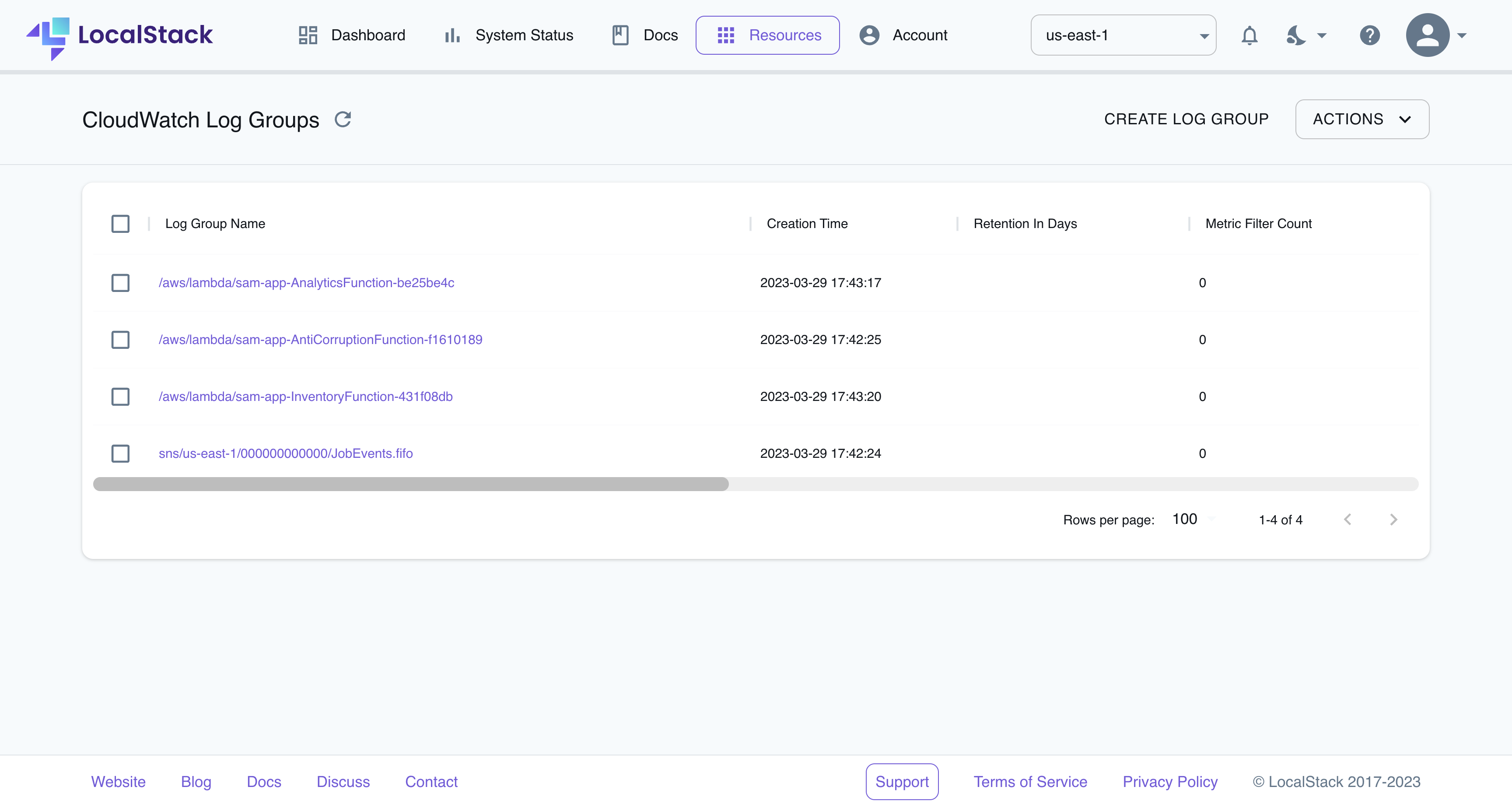| Key | Value |
|---|---|
| Environment | LocalStack |
| Services | SNS, DynamoDB, Lambda, S3 |
| Integrations | SAM |
| Categories | Serverless; Event-driven architecture |
| Level | Intermediate |
| GitHub | Repository link |
The Event-driven architecture with Amazon SNS FIFO, DynamoDB, Lambda, and S3 sample demonstrates a recruiting agency application with a job listings website. The sample application implements three services:
- An anti-corruption service that receives a change data capture (CDC) event stream of changes, translated into meaningful events that are then sent to the SNS FIFO
JobEvents.fifotopic. The interested services subscribe to these events and process them asynchronously. - An analytics service with an SQS FIFO
AnalyticsJobEvents.fifoqueue subscribed to the SNS FIFOJobEvents.fifotopic. SQS FIFO is an event source for Lambda functions, with events stored in an S3 bucket for persistence. - An inventory service with an SQS FIFO
InventoryJobEvents.fifoqueue subscribed to the SNS FIFOJobEvents.fifotopic. It tracksJobCreatedandJobDeletedevents and the data is stored inside a DynamoDB table with the help of the SNS filter policy.
Users can deploy this application on LocalStack and AWS with minimal changes to the Lambda functions using Serverless Application Model. To test this application sample, we will demonstrate how you use LocalStack to deploy the infrastructure on your developer machine and your CI environment. Furthermore, we will showcase how you can check out the event-driven architecture using LocalStack Web Application by verifying the logs.
The following diagram shows the architecture that this sample application builds and deploys:
We are using the following AWS services and their features to build our infrastructure:
- SNS to coordinate the delivery of messages to subscribing clients in the Analytics and the Inventory service by setting a FIFO topic to process events in an ordered manner
- SQS as a distributed message queuing service to implement a FIFO queue which is subscribed to the SNS FIFO topic and acts as an event source for Lambda,
- DynamoDB as a key-value and document database to persist the available job listings from the Inventory service.
- Lambda to create the serverless functions to send job events with business meaning, consume the SQS events in batches and persist the data in S3 buckets.
- S3 to store the analytics for the job events for long-term persistence.
- LocalStack Pro with the
localstackCLI. - Serverless Application Model with the
samlocalinstalled. - AWS CLI with the
awslocalwrapper. - Python 3.9.0 in the
PATH
Start LocalStack Pro with the LOCALSTACK_API_KEY pre-configured:
export LOCALSTACK_API_KEY=<your-api-key>
DEBUG=1 localstack startWe specified DEBUG=1 to get the printed LocalStack logs directly in the terminal to help us see the event-driven architecture in action. If you prefer running LocalStack in detached mode, you can add the -d flag to the localstack start command, and use Docker Desktop to view the logs.
You can build and deploy the sample application on LocalStack by running our Makefile commands: build and deploy. Alternatively, here are instructions to deploy it manually step-by-step.
To build the SAM application, run the following command:
samlocal buildIf you see a Build Succeeded message, you can proceed to the next step.
If the SAM application build fails, you can check if you have the Python 3.9 installed and in the
PATH. Alternatively, usepyenvto switch between multiple versions of Python.
To deploy the SAM application, run the following command:
samlocal deploy --resolve-s3The above command will create a new managed S3 bucket to store the artifacts of the SAM application. If you want to use an existing S3 bucket, you can use the --s3-bucket flag to specify the bucket name. Before being deployed, the CloudFormation changeset will be displayed in the terminal. If you want to deploy the application without confirmation, you can use the --no-confirm-changeset flag.
To view the created resources, check out the CloudFormation outputs from deployed stack or run the following commands
awslocal sqs list-queues
awslocal sns list-topics
awslocal dynamodb list-tables
awslocal lambda list-functions
awslocal s3 lsAfter a successful deployment, you can test the application's functionality by checking out the LocalStack logs (localstack logs). For more verbose logs, we have enabled DEBUG=1, and you can alternatively set LS_LOG=trace-internal to see internal calls between different services.
We offer Resource Browsers in the LocalStack Web Application to help you visualize the resources created by the application. You can access the Web Application by visiting app.localstack.cloud in your browser. Navigate to the CloudWatch Log Groups to verify the Log groups.
You can click on the individual Log groups to view the logs. You can also apply custom filters to the logs, or navigate to the Resource Browsers for other AWS services to view the resources created by the sample application.
This application sample hosts an example GitHub Action workflow that starts up LocalStack, builds the Lambda functions, and deploys the infrastructure on the runner. You can find the workflow in the .github/workflows/main.yml file. To run the workflow, you can fork this repository and push a commit to the main branch.
Users can adapt this example workflow to run in their own CI environment. LocalStack supports various CI environments, including GitHub Actions, CircleCI, Jenkins, Travis CI, and more. You can find more information about the CI integration in the LocalStack documentation.
The sample application is based on a public AWS sample app that deploys an event-driven architectures with Amazon SNS FIFO. See this AWS blog post for more details: Building event-driven architectures with Amazon SNS FIFO .
We appreciate your interest in contributing to our project and are always looking for new ways to improve the developer experience. We welcome feedback, bug reports, and even feature ideas from the community. Please refer to the contributing file for more details on how to get started.

